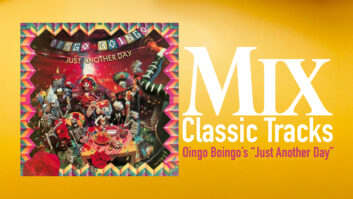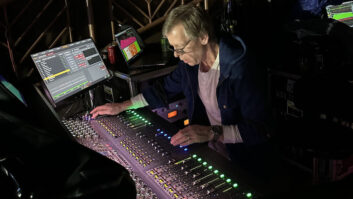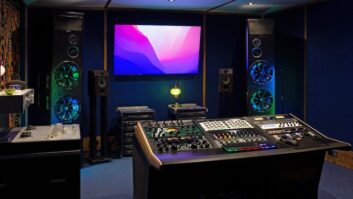
If Ian Brennan is not on your radar, he should be. He has been making music since he was five—well, seriously since he was 20, caring furiously about the world in which we live and giving voice to the disenfranchised masses. Mix was fortunate to speak with him on the phone from his home in Italy, where he resides with his wife, photographer/videographer Marilena Umuhoza Delli.
After working on records in the 1980s and field recordings in the ’90s, Brennan was nominated for Grammy Awards in the early 2000s for numerous traditional folk albums he produced. He then dove into international musical documentation in 2010 with Yigoli Y’ Izahabu, The Good Ones in Rwanda. He traveled with his wife and her mother, who is Rwandan, returning for the first time after losing her family in the country’s horrific period of genocide.
To date, Brennan has amassed more than 40 international recordings over five continents, having learned how to produce projects with very little equipment. In fact, he says, on that first outing, all the equipment broke: “We ended up recording it with three microphones into stereo, and for what it was, it worked amazingly well.”

Included in those international works was Zomba Prison Project in Malawi, nominated for a Best World Music Album at the 2015 Grammys. The story was covered all over the world, including by Anderson Cooper for 60 Minutes. The segment won two Emmy Awards. Then, in 2019, Brennan turned his attention back to the U.S.
“We traveled the world and particularly had been to Africa a lot, but also Asia, South America and Eastern Europe, and it became clear that if you are representing minoritized people, those exist in America too, to a very stark degree,” he says. “Four or five years ago, we did a project with the homeless community in Oakland, where I was born.”
Right before Covid hit in early 2020, he produced a project focused on the disabled community, of which his sister is a part. “Literally, two weeks later, the world shut down and my sister suffered some real horrors and was never the same after that.”
ENTERING THE PRISON
Years earlier, Brennan and team had contacted Mississippi’s Parchman Prison, interested to see how a musical venture might differ since the famed Alan Lomax’s last recordings there in 1959. The chaplain was receptive to the idea of Brennan’s visit, but the administration was not. After Covid, the administration changed, and last year there was a sudden back and forth; with less than a week to prepare, Brennan got the go-ahead.
Not knowing who would participate musically, or what was going to actually occur, Brennan walked through those prison doors all by himself—a crew of one—on a Sunday morning in February 2023. Sixteen inmates from different areas of the large maximum-security prison were brought together, many of whom were strangers and therefore cautious with one another, and shy about singing in front of each other.
Brennan gave them a broad canvas on which to participate—no boundaries to the kinds of songs, their lengths, or who would be the collaborators; it was entirely up to them. Parchman Prison Prayer—Some Mississippi Sunday Morning was released September 15, 2023, to what Brennan says was unexpected global attention.
Because of that, the prison was receptive to a return visit almost a year later to the day, on Super Bowl Sunday, 2024, to record with 12 men—a mixture of some of the same inmates and five new recruits—for a project titled Another Mississippi Sunday Morning, to be released in summer 2025.
There were some differences during this second trip. Instead of two hours, Brennan had four. Photos weren’t allowed the first time, but with some discretion, some pictures were permitted during the second visit. Because of the previous meeting, there was a lot more ease and trust, as well as enthusiasm on the part of the participants, and at the end of the session, Brennan had a big lunch brought in to share with them.
“It was fewer men,” he notes. “Certain people who were involved the first time became very prominent this time; they were also more motivated to write their own songs, so a lot of them had done that in advance. A couple of those from before were really eager to do song after song. Everybody sang at least one song.”

RECORDING IN THE FIELD
Brennan’s equipment on such a project is sparse: one Zoom F8 multitrack recorder, one Sound Devices MP-1 battery-operated, single-channel, portable preamp, one Brauner Phantom Classic mic, two EV RE-20s, two Sennheiser MKH 416s, one AKG 414, one Telefunken M80 (for the lead singer to hold when singing with the full electric band) with mic splitter between P.A. and recording, one Neumann TLM 103, and multiple line splitters for electric instruments between the P.A. and recording deck. It takes Bennan only about 20 minutes to set up, and he can usually break down in five.
The recording took place in a chapel with a 20-foot ceiling, with one wall almost entirely glass—sonically, not ideal. “The reverb that’s on the records is the reverb from the room,” Brennan explains. “There’s no reverb put on the vocals themselves.”
Regarding post-production, Brennan asserts that “on one hand, it’s quite simple because there’s fewer elements; on the other hand, I’ve come to learn that it’s harder; that it’s not as easy as it seems because every element carries so much weight. If things have gone serendipitously with the elements and the microphones and the performances, the mixing is about keeping it as it is; not doing anything to it.”
Brennan mixes everything in the box with Pro Tools, using a minimum of effects—almost no compression, minimal EQ and rarely any reverb at all. “But lots of panning!” Brennan says, with emphasis. “This one ended up being what the first record was mostly supposed to be, which was a cappella, people playing maybe one instrument, or two or three people doing harmony. In the case of the single (‘Parchman Prison Blues’), it’s six guys improvising together.”
There were some external factors that created certain differences from the first to the second project, as well. On the first visit, Brennan notes that it was a cold, but sunny day, while the second time around, it was dreary, overcast and rainy.
“There’s a song called ‘Let It Rain’ that’s really beautiful that was actually sung in the middle of a thunderstorm,” Brennan says. “It sounds like white noise, but it’s actually the rain falling on the roof right when he’s singing it. The first time, there was definitely a tremendous amount of sadness. They had just come through Covid, which had affected everybody, but also this huge crisis at the prison with multiple murders and suicides and horrible conditions with the food—and that had been corrected to a large degree, but it had been recent.
“Now conditions are better,” he continues, “so people are in better spirits; they are being treated more humanely and I think they were proud of what had happened with the first record and were happy to have a Sunday and free time to be able to do this, which was, in and of itself, out of the ordinary and something positive, so there was a lot more positivity. Also, one individual was about to get out, and since the first record, one did get out, so there were those differences as well.”
Conversely, one of the best singers, now 66, is serving a life sentence, having entered Parchman in his early 20s. “He’s been there almost his entire life, and I think if most people met him, they would see that this is somebody who did his time,” Brennan asserts. “It’s not about excusing [what he did] one way or the other, but if prison is supposed to serve a function of correction, you can see that this is a person who is less inclined to be violent than the average person. It’s heartbreaking.”
Brennan hopes that these projects— the voices in particular—humanize the inmates and demonstrate the possibility for emotional growth and redemption. “These recordings help make corporeal the nuance of trauma,” Brennan states. “Every person on every side of a violence action is diminished by it, including (albeit to a lesser degree) the perpetrator.”







